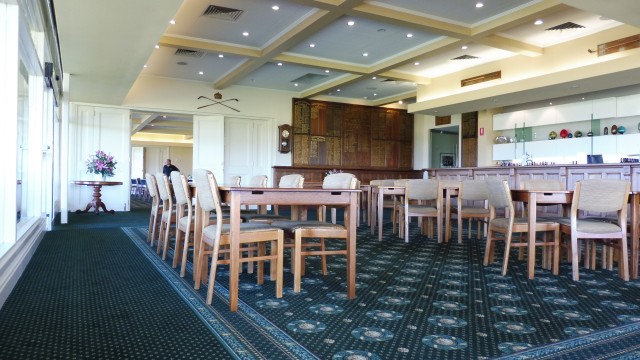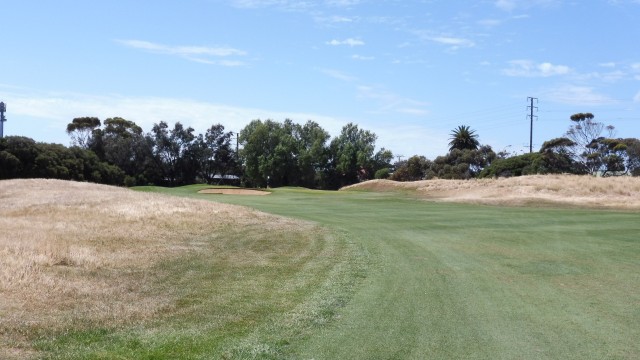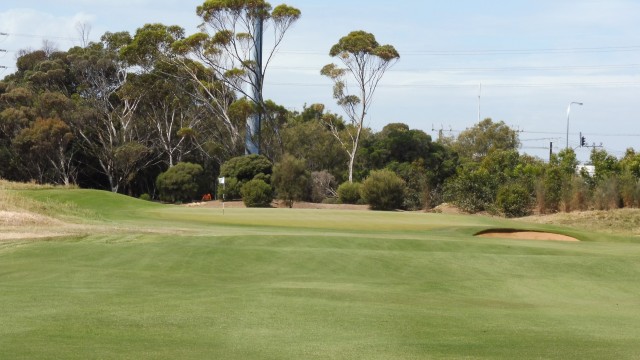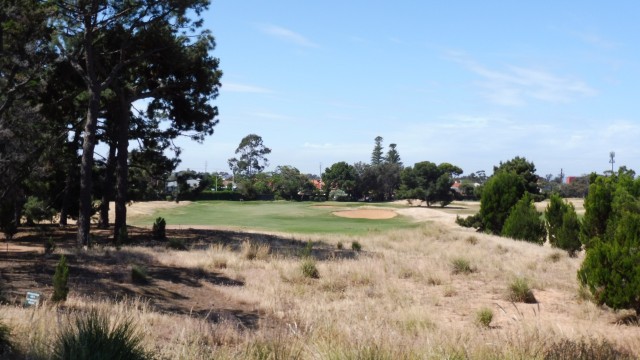
Location: Seaton, SA
Established: 1926
Architect: Dr Alister MacKenzie (1926)/ Peter Thomson & Mike Wolveridge (1979 & 1997)/ Mike Clayton (2009)/ Tom Doak (ongoing)
First Played: 28th Oct 2015
Last Played: 7th June 2018
Magazine Ratings

10 (Current)

11 (Current)
The second game scheduled for my Adelaide trip, was at World renown Royal Adelaide Golf Club. Regularly ranked in the Top 100 Australian lists, but also World Top 100 lists. This is certainly one of the more unique courses I have played in Australia.

Clubhouse at Royal Adelaide Golf Club
Blending in with its natural surroundings, the clubhouse is one of the first things you notice after the large practice areas when driving into the grounds.

The bar area inside the clubhouse
With a large bar area, as well as tables outside to watch players finish their rounds at the 18th. History is found throughout the clubhouse. I was quite surprised with how many offshoot rooms there were in the building, with most giving that heritage type of feel.

Locker room at Royal Adelaide Golf Club

Danger Danger Railway Crossing
There have been two iterations of Adelaide Golf Club. The first, although located on different land, only lasting a few years in the 1870’s. The second originally started in 1892 near the Glenelg Golf Club. Eventually this was not suitable and land was purchased near Grange. In 1906 Seaton links was officially opened. In 1923 the ‘Royal’ title was given by King George V, becoming the fourth ‘Royal’ club in Australia.

Train passing through in front of the 18th green
This is the only course I have been to which has a train line running right through the middle. There have been plenty where train lines run just outside the boundary, but never between. In the early days there was a station located on the property, which was used by members to visit the club, travelling from the city.

Map of Royal Adelaide Golf Club
So I mentioned this was one of the most unique courses. A major part of this is due to the train line running through the middle, but the other being the massive craters in some of the dunes, even though it is still a little way from the beach. Admittedly this is only on some holes, but coupled with the look of the yellow, wispy grass on the side of the fairways, and exuberant green running between, also added to the feel.

Scorecard for Royal Adelaide Golf Club
Great to see traditional scorecards. There are still a few clubs out there with cards which are unique to the club. As much as I love the simplicity of the electronic score card systems, like filling in a Lotto ticket, they all look the same and have no character.

Hole 1 – 342 meter par 4
A short stroll from the driving range brings you to the first tee, or a bit of a longer walk from the clubhouse around the 18th green along the train line, if you haven’t warmed up. The first, a mid length par 4 with a turn to the left, asks you a question with your first shot. Play safely to the wide fairway before the turn, or take on a bit more distance and potentially end up in the longer grass, failing to carry the hump or running too long.

Approach from the 1st Fairway
Laying up leaves a longer shot and depending on if you are left or right, will see the bunker come more into play. Further right allows a shot to run into the putting surface, whilst left may mean carrying the trap. I was taken in from hole one and knew I would be in for a terrific journey.

Hole 2 – 468 meter par 5
From the championship tee, the railway lines must be carried to reach the fairway. This gives quite a different angle for the tee shot and hopefully no train being hit.

Standard area for 2nd tee
For the normal everyday player, the second, a mid length par 5, plays fairly straight, running along the train line. Bunkers encroach on the fairway at various stages, with the fairway weaving its way along this uphill hole.

Looking back from 2nd green
A slight hollow is found just before the green, with two bunkers either side. This green complex had further mounds and hollows at the rear also. A strong breeze playing across and slightly into my face, made this quite a long hole.

Hole 3 – 265 meter par 4
The easiest hole and shortest par 4 on the course, is probably also one of the best. The tee shot is blind, over a hill. The big question is whether to take on the green or lay up.

Playing to the front of the 3rd Green
Anything wide on this hole finds trouble, so accuracy is key. If laying up you need to land on top of the hill, otherwise an awkward stance will be found with a downhill shot, to a very narrow green. No matter what the play, it isn’t ideal ending up left of the green. With the putting surface being pencil thin, chipping over the mound will require the ball to stop on a dime.

Looking back from the 3rd green
Certainly a memorable hole for the day. I had read some stories about the hole before visiting, but obviously didn’t pay enough attention. This is now up there with one of my best short par 4 holes in Australia.

Hole 4 – 369 meter par 4
Just to get the juices flowing, the next tee shot must carry a large crater, before finding the fairway, which is blind from the tee. Ensure you climb the ladder to take in the view and find where you need to aim. There is also a nice view of the 3rd green.

Wide open 4th fairway
One thing about this hole, is the vast space that can be found on the fairway from the tee. Also note the numerous mounds found. I did mention this was a links course didn’t I? The hole sweeps around to the left for the approach, but is still quite open leading into the green.

Approach to the 4th green
As you get closer to the green, more bunkers come into play, the Doctor at some of his finest. The green has a slight ridge through the middle but is quite large. Another classic designed hole which was registered to the memory bank.

Hole 5 – 374 meter par 4
Another slightly longer par 4, but this time turning to the right. This is probably one of the flatter parts of the course, but the use of slight mounds and the bunkers, plus colouring of the grass, makes it still look interesting. Again plenty of room to land the ball if playing safely, but hitting past the traps, this narrows dramatically.

Playing in to the 5th green
A few small mounds are found along the approach to the green, which also has a slight rise at the front. Not as memorable as the previous holes, but still classic design.

Hole 6 – 393 meter par 4
Playing the longest par 4 hole on the course, this plays fairly straight. A pretty wide landing area, although their is a couple of traps to the left. Playing too far to the right brings trees into play for the second.

The Elevated 6th Green
Playing the approach requires allowance in club selection, as the green is raised a bit. Anything short will struggle to run up to the putting surface. More bunkers are in play either side of the green, with the rear running away. Didn’t rate as highly as some of the other holes.

Hole 7 – 148 meter par 3
The shortest par 3, is probably the standout as well. From the tee sandy waste must be carried, otherwise a terrible lie may await, but even more so is the craters running the full front of the green. It looks like someone was playing war games over the putting surface.

Strong sloping 7th Green
From the tee, the green is slightly elevated, but it is the putting surface itself which also proves testing. Sloping quite dramatically from the rear, being long is not ideal. A tricky hole for any tee shot that is slightly inaccurate, but certainly a stand out.

Hole 8 – 322 meter par 4
Another favourite was this short par 4. Playing from a slightly elevated tee, there is a small carry over an area under going re-vegetation. The fairway is one of the narrower on the course, but lined with large mounds and a few bunkers. This has true risk and reward. The longer you hit, the greater the risk of finding trouble, like the sand.

Deceptive 8th green
The approach to this small green has to be fairway accurate, although it does look smaller than it actually is, with a deceptive mound at the front hiding part of the green. I find it interesting that I liked the hole so much. It has two things I am not a big fan of usually. One a forced carry (from the tee to fairway although not overly long) and the second a quite narrow fairway. So how can I really like a hole that goes against my strong dislikes? Probably due to the fact I can see quite distinct strategies for the hole.

Hole 9 – 483 meter par 5
Finishing the front nine is the longest and hardest par 5 at Royal Adelaide Golf Club. With a long sweeping turn to the right, a carry is required before finding the fairway.

Travelling along the 9th fairway
There is ample room for the tee shot to land. Long hitters will find the fairway narrowing with a multitude of bunkers to the right and trees starting to encroach to the left.

Looking back from the 9th green
The approach to the green is up gradual slope, getting steeper closer to the pin. There are few bunkers at the front, with mounds and run off areas towards the rear, separating the green from the 10th tee.


Hole marker and pin flag
The hole markers are simple and look like they could be replaced, could be forgiven thinking they are are the originals from the opening of the course.

Hole 10 – 334 meter par 4
A blind tee shot over a hill, this medium par 4 can be a bit of a surprise first time playing. Firstly no idea on the line, hint, middle to left of the fairway. After traveling over the hill this becomes more evident. The fairway slopes strongly to the right, feeding into longer grass, as well as coming to an abrupt halt.

End of the 10th fairway
Once on the downside of the hill, you find sandy waste separating the green complex from the fairway. Pictured above is the smaller grass, much heavier to the right.

Sloping away on the 10th green
Not only is it possible you will be playing from a down hill slope, but the green also slopes mostly away, although there is a small portion at the front sloping back towards the fairway. Ranked 15 on the course, I am a bit surprised as it certainly can have its challenges. Definitely a hole you need to play twice.

Hole 11 – 350 meter par 4
The famous ‘crater’ hole, is a medium length par 4. From the tee there is quite a bit of carry to reach the fairway, almost playing across the 10th green. The tee shot is blind over a hill, with a large bunker to the right, but also one further along left.

The 11th green built into the crater
If you don’t know it is possible to drive through the fairway. Sandy waste is found between the fairway and green complex, which is built into the hill. Extremely scenic approach shot. I love the look of it, intimidating tee shot and scenic approach. Strategy is mainly off the tee, do you hit over the hill, but bring into play a potential downhill approach or finding the waste, or layup short of the hill leaving potentially a semi blind approach. Players who do not hit the ball long will either take at least three shots to reach the green, or be forced to play through the waste. In fact I had two elderly gentlemen playing behind me. Would have been curious to see how they approached the hole.

Rotunda in the middle of the course
Royal Adelaide Golf Club does not route back to the clubhouse after the front 9. Instead there is a rotunda with amenities and vending machines. Quite handy to keep the fluids or energy up. Also a great view out over the course.

Hole 12 – 201 meter par 3
The longest and hardest par 3 is next. Playing down hill, the target looks quite small and hard to hit, especially in the afternoon winds. A slight carry is required over some lovely marram grass (not really fond of this after playing at Port Fairy Golf Links), although for the shorter hitter, there is a slight gap to the left to navigate.

Looking across at the 12th green
The green complex is slightly raised, repelling anything towards the edges. There is also one lonely bunker sitting to the front left. This looks a simple hole, but could be quite punishing with the shaping of the green.

Hole 13 – 354 meter par 4
Another classic designed hole, a mid length par 4 with a dog leg to the left. The tee shot is almost from an island in the middle of a waste area, leaving a slight carry over before reaching the fairway. There is plenty of room to land the tee shot, but the further right you go, the longer the approach. Taking on the corner could find tree trouble.

Approach to the 13th fairway
Playing in to the green the fairway remains quite wide and open. The ground slopes slightly to the right, bringing the bunker on the left a bit more into play for those running the ball in. You can’t really fault classic designed holes and this is one of them. Nothing too fancy, but can be played in numerous ways.

Hole 14 – 382 meter par 4
After crossing the railway lines we move out to the other side of the golf course. Another of the most recognised holes is the 14th. The championship tee requires play carrying the train lines, I ponder if any trains have been hit. Water is in play off the tee to the right, which is the first sign of water, besides the drinking fountain at the rotunda. Beyond this are a cluster of bunkers built into the hill on the right. The fairway has a variety of slopes to contend with.

Carry the waste to the 14th green
It is the approach which stands out. The green is located beyond a large ditch, with a fair bit of waste beneath, with trees either side. From the fairway it is not obvious of the carry, so anything slightly short will be repelled back down a hill. Three bunkers line the sides of the green, making this even more intimidating . It certainly requires a pretty accurate shot.

Hole 15 – 450 meter par 5
The last par 5 for the day is the shortest and easiest ranked. The tee shot is over a waste area and through a chute of trees to a fairly receptive fairway. From here though it remains fairly flat, although bunkers have been well placed and the fairway cuts in at various points to ensure you at least think about your shots to the green.

Looking back from the 15th green
The green angles away to the right and is protected by one bunker slightly short to the left and another green side on the right. A hole not up to the standard with the rest of the course.

Hole 16 – 156 meter par 3
The last par 3 for the day is the easiest. The hole stands out among the natural grasses surrounding it and the lone tree to the right.

The 16th green with 17th in the background
Surrounds of the green complex slope away on all sides with the exception of the front. One thing that I prefer with courses is firm short cut grass around the greens. Having the ability to play shots in many ways makes the game a lot more enjoyable.

Hole 17 – 365 meter par 4
Most critics actually say that from the 15th Royal Adelaide Golf Club is not very interesting, compared to the rest of the course, but the 17th has to be one of the most talked about. In its current form, the fairway is split in the middle by four bunkers. To the right the ground is lower and slightly flatter. To the left there are two ridges to play over. If you are long enough these can be carried, but if landing on either, could leave a difficult approach shot.

Bunkers to the rear of the 17th green
The green itself has bunkers either side and to the rear, although I suspect that these will not find too much play. Sloping of the green is predominantly from the front to rear. So I mentioned this is a much talked about hole. Michael Clayton was originally engaged to create a masterplan for the club. The 17th was the first to undergo changes, to get a feel from the membership base. The changes were very controversial and hotly debated in the club. In the end Tom Doak was sought to modify the hole again. To get a good overview of the original hole, Clayton’s redesign and Doak’s final version, visit the post on Golf Club Atlas.
Having never played the original and Clayton’s design I can’t really comment. I like the hole and it is enjoyable to play, with many options to take, but the hole is still a stark difference from the rest of the course, which was an issue with the first redesign.

Hole 18 – 369 meter par 4
To finished the round is a medium length par 4 which turns slightly to the left. The approach to the green is played over the entrance road, so caution with the cars.

One last view of the 18th green
Two large bunkers are located right of the last green, along with some dense grass. Sitting in front of the clubhouse, it is ideal for any viewing of major competitions, but it is not one of the strong holes on the course.

Hole 19 – A short par 3
As with most modern courses, Royal Adelaide has built an extra hole, to allow maintenance to be conducted without reducing the course to 17 holes. This had opened not long before my visit in 2018 and is a short par 3 tucked away in the corner, near the 17th green.

View of the 19th green
With two bunkers to the front of the green, there is actually ample room to miss to short or left. The green has some subtle slopes to contend with, although playing in from the left will be one of the more tricky places.
Overall the experience of playing at Royal Adelaide Golf Club was fantastic. I was taken in by the layout and design of the course as well as some of its peculiarities, like having a train line run right through the middle. The flow of the course was seamless and I find the play enjoyable. There was a great mix of classic design on some of the holes, while the ones unique, especially 3, 7 and 14 visually stunning. The links feel certainly came through in how the course played. Most definitely a bump and run required at times, with firm fairways allowing quite a bit of run, also fast and firm green complexes. Looking at the mixture of holes, there was sufficient length variation between the different par types. Even when you had holes with similar lengths repeating, the difference in design ensured that you did not really notice.
It is hard to find too many faults with the course, although I did find from hole 15 on not as exciting as the first 14 holes. The style of 17 still needs to be addressed as it stands out to be totally different from the rest of the course. Its not an issue having a much wider fairway, but it really feels like you are on a different course. Changing the remaining holes would potentially take what is unique at Royal Adelaide away. Looking at photos from the entire course, I do notice that the 4th fairway is just as wide, but as this is surrounded by the other holes, it does not stand out anywhere near as much. Anyway it is a problem which will not disappear in a hurry.
Sitting in the clubhouse, well actually outside, was a great way to finish the day with some local ales. The food was top quality and taking in people finishing on 18 on a beautiful Adelaide day, was a good way to reflect on one of the highlights of my trip. Look forward to returning one day and playing again.
These are the ways in which to play at Royal Adelaide Golf Club:
1. Be invited by a member
2. Be an interstate or overseas visitors – you don’t have to be a golf member but this is more expensive
I played at the club as an interstate visitor who is a member of a golf club.

